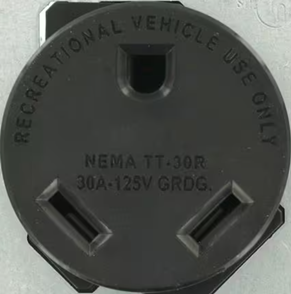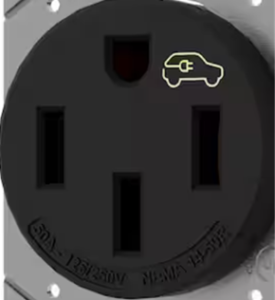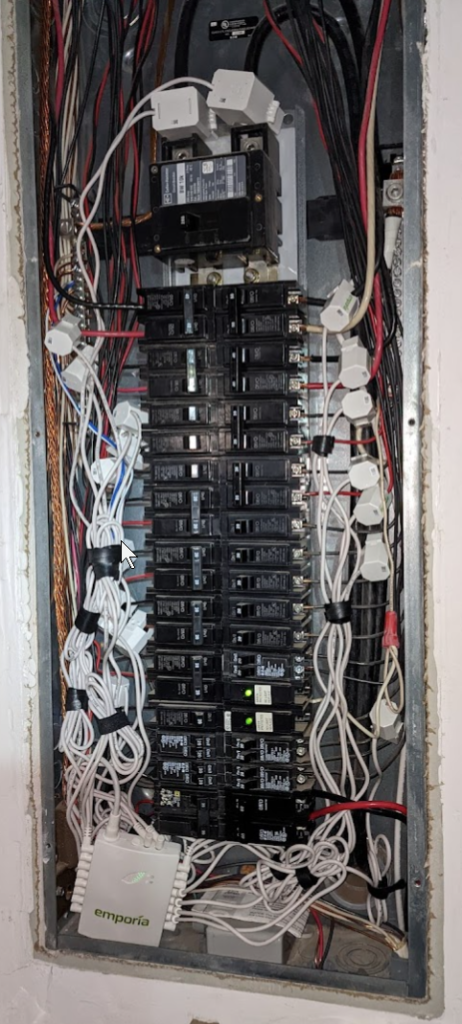If you are purchasing an EV or about to you need to consider the different options you have for charging at home. You can use a hard-wired “Level 2” charger or a “Level 2” plug-in charger.
My suggestion is this one: https://www.chargepoint.com/drivers/home from ChargePoint.
The “Level 1” charger that came with your car is practically worthless except as a trickle charger – and evidently in the winter it’s not even good enough for that considering newer cars heat the battery pack during charging in the winter. They actually use more electricity than it takes in on a “Level 1” charger. “Level 1” chargers mean your using 120 VAC, single phase. One may think they could buy a Level 1 charger with a 30 amp plug to use at an RV park with the NEMA TT-30R, however I’ve not found a Level 1 charger that is rated higher than 15 Amps.
The “Level 2” charger uses 240vAC (aka Split Phase) but more on that later.
Let’s calculate the charging times for a 64 kWh battery pack using different voltage and amperage combinations. We’ll use the formula T = C / (V * A * E), where T is time in hours, C is battery capacity in kWh, V is voltage, A is amperage, and E is charging efficiency.
Assuming a charging efficiency of 90% for all cases:
(Note that often I mistakenly interchange the NEMA 5-30 when I mean the TT-30R. The NEMA plug is wired the same but physically different from the TT (TT stands for Travel Trailer), 30R is for 30A Receptacle. If you needing a charge and an RV park is the only option they will have the TT-30R and maybe a NEMA 14-50). A NEMA 14-50 is a “Split Phase”, 250v AC circuit. Split Phase basically means 2 of the 3 prongs have 120v and between them is the 3rd prong which is Neutral (the split). In general, all outlets in a normal home in USA are 120v AC on the ‘hot’ wire accompanied by a neutral and ground (not hot). The Split Phase has two hot wires, a neutral and a ground. Your home is supplied power from the utility company using two hot wires at 120v AC each, a Neutral and a Ground.
220V 50A Charging (NEMA 14-50R)
Power = 220V * 50A = 11,000W = 11kW
Actual charging rate = 11kW * 0.9 = 9.9kW
Time = 64 kWh / 9.9kW = 6.46 hours
120V 30A Charging (NEMA TT-30R)
Reminder, for car charging this is a “Level 1” and I’ve not seen a Level 1 30 amp charger. I’ve seen up to 20 A but not 30A. So this math is just for demonstration: One could make an adapter for the 15 Amp or 20 Amp plug from the 30A plug if the TT-30R is the only one available.
Power = 120V * 30A = 3,600W = 3.6kW
Actual charging rate = 3.6kW * 0.9 = 3.24kW
Time = 64 kWh / 3.24kW = 19.75 hours
120V 20A Charging (NEMA 5-20R)
Power = 120V * 20A = 2,400W = 2.4kW
Actual charging rate = 2.4kW * 0.9 = 2.16kW
Time = 64 kWh / 2.16kW = 29.63 hours
If your using a plug-in instead of a hard-wired charger – here is what the plugs should look like.
| North America Standard | Image |
|---|---|
| NEMA 5-20 Receptacle 120v 20 Amp |  |
| NEMA TT-30 Receptacle 120v 30 Amp (TT for Travel Trailer) |  |
| NEMA 14-50 Receptacle 250v 50 Amp |  |
I originally wrote the text below in April 2022.
While waiting on the car to be delivered I bought and installed the “Level 2” home charger. Because my breaker panel was full I had to buy some dual-slim breakers (basically two breakers in the space of one) and then I could add the 60-amp dual breaker necessary for the home charger. While doing all this I became concerned I could trip the main 100 amp breaker at the top of the load center so I also installed an Emporia “Emporia Smart Home Energy Monitor with 16 50A Circuit Level Sensors | Real Time Electricity Monitor/Meter | Solar/Net Metering”. My concerned was ‘what if the air conditioner and stove top and microwave are using power and I’m trying to charge the car”. My fears were unnecessary as everything only pulls about 1/2 the amperage it’s rated at and I can program the car to only charge after 9 PM. Again, the engineer in me it really excited to see the amperage per second for each breaker I put a sensor on! Neat stuff!
For the home charger I purchased “ChargePoint Home Flex Electric Vehicle (EV) Charger, 16 to 50 Amp, 240V, Level 2 WiFi Enabled NEMA 14-50 Plug or Hardwired, Indoor / Outdoor, 23-foot cable”. I removed it’s plug and hard wired it in with a 60 amp breaker (bottom right of this photo)

Below you can see how I hard wired the charger. Three wires for L1, L2 and Neutral, 6 AWG. Tough stuff – had to use 1″ PVC for most otherwise it would not have the needed bend radius.

All finished… The 220v 50A car charger, the 110v lawn mower battery chargers, an 220v air compressor power receptacle and a 110v regular receptacle near the garage door for convenience of plugging in a saw, drill, etc. The other grey box is southwestern bell’s demarcation box.

Math
<# useless info
I was surprised to find that the Kia Niro EV is 660 lbs heavier than the Kia Niro Hybrid.
Kia Niro EV, EX Premium min curb weight: 3,854 lbs
Kia Niro Hybrid, EX Premium min curb weight: 3,192 lbs. ( – 662 lbs)
#>
After driving the car in the city for the past month I’ve come up with the following statistics:
March 2022 (with OEM wheels)
156 miles to/from work from 80% charge to 10% battery remaining
OG&E Feb bill: $138.14/1246 kWh = 11 cents/kWh (this includes tax, etc) for off-season non-Smart-Hours plan. Note: During Smart-hours season if the evening rate is $0.08 cents/kWh then the cost is ever so slightly lower.
Kia documents show the battery energy is 64 kWh.
My ChargePoint shows I charged 52.75 kWh, so the cost was $ 5.84
That is about right, 52 kWh is 80% of 64 kWh.
My commute to/from work is exactly 30 miles/day or 19% of my mileage.
So 19% of my charge cost is $ 1.12 per day round trip.
Therefore I need to charge every 5 days if to/from work are my only trips.
NOTE: I am in Economy mode and I usually set cruse control to 70 mph when not stuck in heavy traffic.